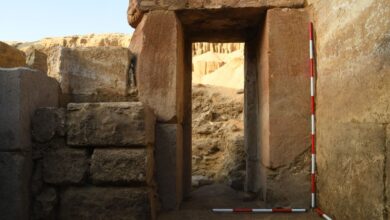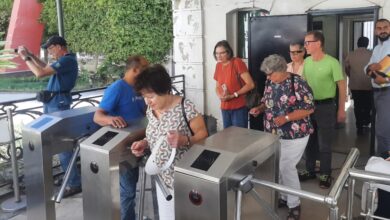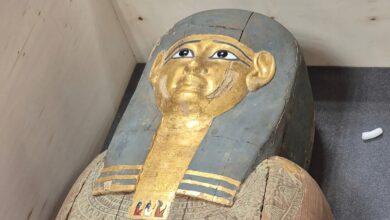إنتهاء رأي اللجنة إلى عدم الموافقة على إعادة تركيب أي من الكتل الجرانيتية الموجودة حول جسم هرم منكاورع
وزير السياحة والآثار يتسلم تقرير اللجنة العلمية العليا المشكلة لمراجعة مشروع الترميم المعماري لهرم منكاورع .. بعد اجتماعات وزيارات اللجنة لهرم منكاورع ومناقشة النظريات العلمية المختلفة .. إبداء الموافقة المبدئية على القيام بأعمال التنقيب الأثري حول هرم منكاورع بعد تقديم خطة شاملة قبل بدء الأعمال

كتبت / د. أميرة نصار
تسلم اليوم السيد أحمد عيسى وزير السياحة والآثار، التقرير الذي أعدته اللجنة العلمية العليا المشكلة برئاسة عالم الآثار ووزير الآثار الأسبق الدكتور زاهي حواس، وعضوية ستة من كبار العلماء والخبراء المتخصصين في مجالات الآثار والهندسة من المصريين والأجانب من الولايات المتحدة الأمريكية، وجمهورية التشيك، ودولة ألمانيا، لمراجعة المشروع المشترك بين المجلس الأعلى للآثار وبعثة جامعة واسيدا اليابانية، والمقدم لإجراء أعمال الترميم المعماري لهرم منكاورع بمنطقة آثار الهرم.
وقد استهلت اللجنة التقرير، بالإشارة إلى التعاون المثمر للمجلس الأعلى للآثار الذي أمد اللجنة بكافة البيانات والمعلومات اللازمة والمستندات الخاصة بالمشروع، مما مكنها من إنجاز أعمالها على الوجه الأمثل وفي أسرع وقت، ومن بينها قرارات اللجنة الدائمة للآثار المصرية، والتي كانت قد وافقت على قيام معهد المصريات التابع لجامعة واسيدا اليابانية بالبدء في إعداد الدراسات اللازمة لتنفيذ المشروع المشترك للترميم المعماري لهرم منكاورع بالاشتراك مع المجلس الأعلى للآثار.
وأوضح التقرير أنه في ضوء الاجتماعات المكثفة التي عقدتها اللجنة والزيارات التي قامت بها لهرم منكاورع، وما تم مناقشته وطرحه للنقاط والنظريات العلمية، اتفقت اللجنة بكامل أعضائها على عدم الموافقة على إعادة تركيب أي من الكتل الجرانيتية الموجودة حول جسم هرم منكاورع، وضرورة الحفاظ على حالة الهرم الحالية دون أي إضافات لما له من قيمة أثرية عالمية استثنائية، ويمكن الاستدلال على شكل الكساء الأصلي للهرم من خلال المداميك (الصفوف) السبعة الموجودة حاليا على جسم الهرم منذ آلاف السنين.
وأكدت اللجنة على أنه من المستحيل التأكد من المكان الأصلي والدقيق لأي من هذه الكتل الجرانيتية على جسم الهرم، كما أن إعادتها سوف يغطي الشواهد الموجودة لطرق وكيفية بناء المصريين القدماء للأهرامات.
ووفقا للتقرير، أبدت اللجنة موافقتها المبدئية على القيام بأعمال التنقيب الأثري للبحث عن حُفر مراكب هرم منكاورع (مثل تلك الموجودة بجوار هرمي خوفو وخفرع) شريطة أن يكون هناك أسباب علمية واضحة ومفصلة يتم تقديمها في دراسة يتم عرضها على اللجنة العلمية العليا قبل البدء في هذه الحفائر، وألا تقتصر الأعمال على فكرة البحث عن حُفر المراكب أو المراكب فقط.
كما أيدت اللجنة المشروع العلمي الأثري المقدم لدراسة والرفع المساحي لهرم منكاورع وتنظيم الكتل الجرانيتية المكونة للكسوة الخارجية المتساقطة منه، والقيام بأعمال الحفائر للكشف عن باقي هذه الكتل ذات الزوايا المائلة حول الهرم، بالإضافة إلى تنظيف وتنظيم الموقع للزيارة، مؤكده على عدم البدء أو القيام بأية أعمال علمية أو أثرية في هذا المشروع إلا بعد قيام مدير المشروع بتقديم مقترح تفصيلي متكامل للمشروع يتضمن خطة عمل علمية شاملة، وذلك لمناقشتها باللجنة والتي بدورها سوف ترفع تقريراً علمياً لوزارة السياحة والآثار للتنسيق مع منظمة الأمم المتحدة للتربية والعلم والثقافة (اليونيسكو)، وللعرض على اللجنة الدائمة للآثار المصرية.
وأكدت اللجنة على ضرورة أن تتضمن خطة عمل هذا المشروع التي سيتم تقديمها، المدة الزمنية لتنفيذ المشروع، وأسماء أعضاء فريق العمل من الآثاريين الذين يجب أن يتمتعوا بخبرة في مجال التسجيل والتنقيب الأثري ودراسة طبقات الأرض، بالإضافة إلى ضرورة أن يتضمن فريق العمل مهندس ذو خبرة في مجال التراث الثقافي والترميم، ومهندس معماري يتمتع بخبرة في العمارة، مشيرة إلى ضرورة أن يتفرغ مدير المشروع تفرغاً كاملاً لتنفيذ هذا المشروع العلمي الأثري.
جدير بالذكر أن اللجنة العلمية العليا كان قد تم تشكيلها الأسبوع الماضي وفقا للقرار الوزاري الصادر من وزير السياحة والآثار، بتشكيل لجنة علمية عليا برئاسة الدكتور زاهي حواس عالم الآثار ووزير الآثار الأسبق وعضوية كل من الدكتور ممدوح الدماطي وزير الآثار الأسبق و المشرف على قسم علوم الآثار والحفائر بكلية الآثار جامعة عين شمس، والدكتور هاني هلال وزير التعليم الأسبق وأستاذ الهندسة بجامعة القاهرة، والدكتور مصطفى الغمراوي رئيس قسم الهندسة الإنشائية الأسبق بجامعة القاهرة، والدكتور مارك لينر عالم الآثار ورئيس جمعية أبحاث مصر القديمة، والدكتور مروسلاف بارتا عالم الآثار ومدير المعهد التشيكي للمصريات، والدكتور ديترش راو مدير معهد الألماني للآثار بالقاهرة.
——
وزارة السياحة والآثار
The Menkaure Pyramid Review Committee released its scientific report and disapproved of the re-installation of the pyramid’s casing blocks
The Menkaure Pyramid Review Committee (MPRC), has unanimously objected to the re-installation of the granite casing blocks, scattered around the base of the pyramid since thousands of years ago. The decision was delivered in a report submitted today to the Minister of Tourism and Antiquities Ahmed Issa.
The report stated that, after extensive meetings and visits to the Menkaure Pyramid at Giza Plateau, the committee unanimously agreed to disapprove of the reinstallation of any of the granite blocks surrounding the base of the Menkaure Pyramid, underlining the importance of maintaining the pyramid’s current state without alterations, given its exceptional universal and archaeological value. As for the original form of the pyramid’s casing, it can be determined through the seven existing casing presents on the pyramid body.
The MPRC asserted that it would be impossible to ascertain the exact original position of any of the casing blocks, therefore, it is impossible to return any of them to their original location on the pyramid. Consequently, any reinstallation of the casing blocks would change the ancient, original fabric and appearance of the pyramid which would conceal important evidence of how the ancient Egyptian designed and built the pyramids.
According to the report, the MPRC granted initial consent to carry out archaeological excavations to uncover Menkaure pyramid’s boat pits (akin to those discovered near the pyramids of Khufu and Khafre), contingent upon the provision of clear and detailed scientific study to be submitted to the MPRC prior to the commencement of any excavations. Moreover, the MPRC declared that the search of the pyramid’s boat pits should not be a high priority, nor a reason, for excavating the base of the Menkaure Pyramid. This Project should state broader, more scientific reasons for undertaking such excavations.
The MPRC also endorsed the scientific archaeological project proposed for studying and surveying the Menkaure Pyramid, organizing the fallen granite blocks of its outer casing, and conducting excavations to uncover the sloping debris around the pyramid, as well as the cleaning and organization of the site for visitation. However, the MPRC affirmed that there no scientific or archaeological activities in this project should commence until the project director presents a comprehensive research proposal, including a detailed scientific work plan, for discussion by the committee which will subsequently submit a scientific report to the Ministry of Tourism and Antiquities (MoTA) for coordination with UNESCO and presentation to the Permanent Committee for Ancient Egyptian Antiquities.
The research proposal should state the sources of funding to carry out the Project and time-frame required for implementation as well as a list of team members and résumés for each. The team should consist of skilled archaeologists experienced on the best practices of stratigraphic excavation and recording, in addition to an architectural historian, with experience in ancient Egyptian architecture and restoration, and an engineer experienced in cultural heritage and restoration. Meanwhile, the project director should be employed full-time on the Menkaure Pyramid Project. He should not be otherwise employed or assigned other duties within the MoTA.
The committee mentioned that it was able to complete its work efficiently thanks to the documents provided by the Supreme Council of Antiquities (SCA), among them the decisions taken by the Permanent Committee for Ancient Egyptian Antiquities showing its approval of the architectural restoration project of Menkaure pyramid submitted by the Egyptian Japanese archaeological team SCA and the Waseda University.
The MPRC started its work early last week upon a ministerial decree issued by MoTA minister Ahmed Issa, to review the restoration project for the Menkaure pyramid at Giza plateau, introduced by an Egyptian Japanese archaeological team from the SCA and the Waseda University. It is chaired by renowned Egyptologist and former Minister of Antiquities Zahi Hawass and consists of six members of pioneer engineers and archaeologists, from Egypt, the United States, the Czech Republic, and Germany including Prof. Mamdouh El-Damaty, Former Minister of Antiquities and Supervisor of Egyptology Section at the Faculty of Archaeology at Ain Shams University; Prof. Hany Helal, Former Minister of Education and Professor of Engineering at the Faculty of Engineering at Cairo University; and Prof. Moustafa El-Ghamrawy, Former Head of the Civil Engineering Department at Cairo University; Dr. Mark Lehner, Director and President of the ancient Egypt Research Associates; Prof. Dietrich Raue, Head of the German Archaeological Institute in Cairo and Prof. Miroslav Bárta, Director of the Czech Institute of Egyptology at the Faculty of Arts of Charles University.














